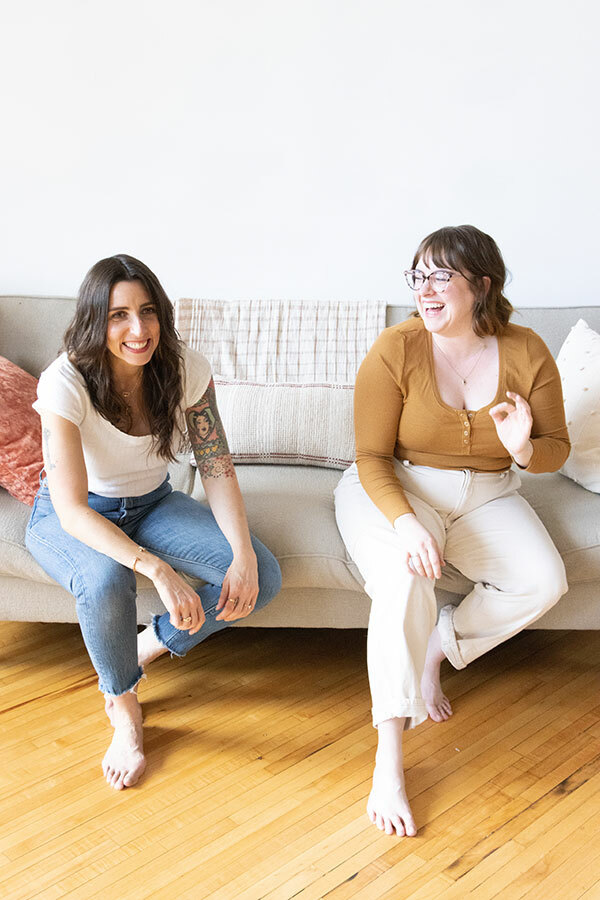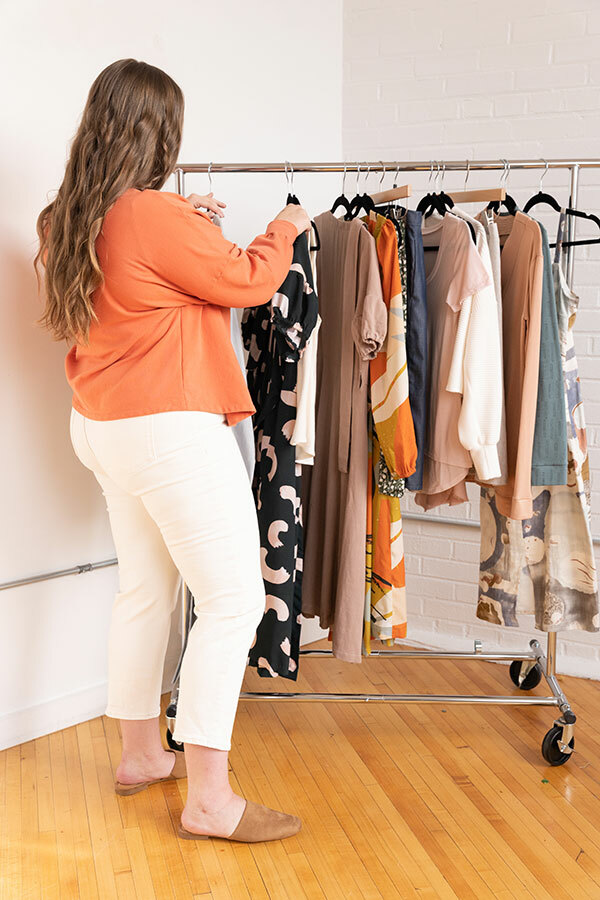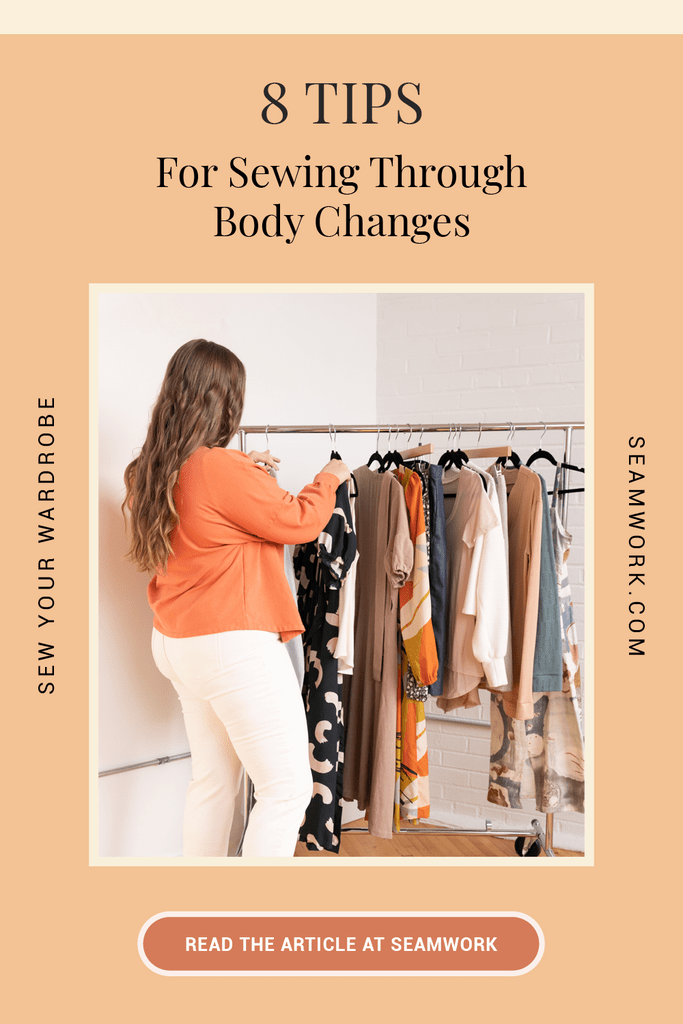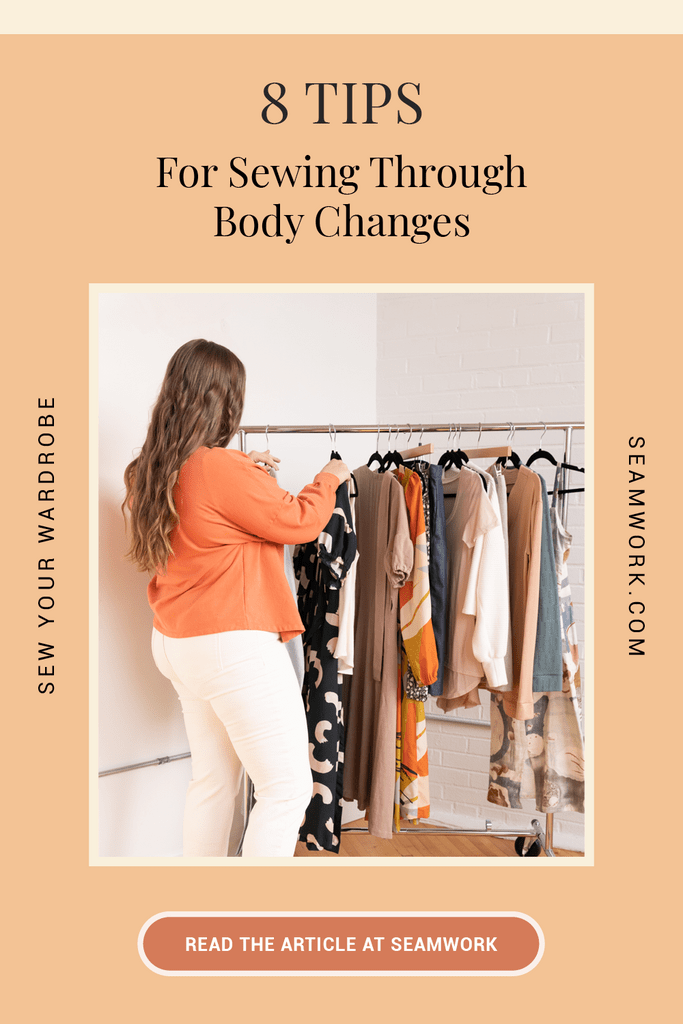Self-expression can make you feel really vulnerable. Your clothes are an extension of yourself, and when you sew your own clothes, every stitch is a place for self-expression. And when you express yourself, you’re open to criticism or judgment.
On top of that, sewing brings your attention to your body—there’s no way around that—and it can be hard to feel creative when working so closely with your body. You’re hyper-aware of what you look like in the mirror, you spend a lot of time analyzing how clothes fit and feel on your body, and above all, you have to write down all of your measurements, often several times a year. So sewing shines a bright spotlight on any changes your body might be going through. Changes of all kinds are complex, but changes in your body are remarkably intimate.
It’s normal to feel discouraged when your body changes, but it doesn’t mean you have to give up sewing.


Here are some tips for sewing throughout your body’s changes. For a larger discussion, listen to episode 84 of Seamwork Radio. Sarai and Haley share how they’ve learned to sew through all sorts of body changes, like pregnancy, changes in physical activity, and navigating style changes as you get older.
-
Identify parts of your body that aren’t changing that much and sew for those. For example, your shoulders and upper chest might not be prone to significant weight fluctuations, so choose designs with style lines that highlight those parts of your body and focus on growing your sewing skills with fitting adjustments for those areas. For example, button-ups that fit well at the shoulders can have added ease at the waist and hips to allow weight fluctuations. -
Sew with knits, elastic, and drawstrings so you can expand or cinch as your body changes. This doesn’t mean you need to eternally sew sweatpants. Choose designs that have a waistband with a flat front and elastic back, like the
Max pants or Dorian shorts. Patterns that have drawstrings can be let out or pulled in, like the Lucy jumpsuit or Miller shorts. -
Sew outerwear. You can often still sew outerwear when you're going through body changes. Outerwear projects are also usually really satisfying and might help you learn new techniques like welt pockets, linings, or working with specialty fabrics. The sizing is more forgiving since you can layer jackets, coats, and vests over sweaters, meaning a little more room won’t hurt. For example, Jill, Albion, and Francis can be sewn slightly oversized, graded out in the waist and hips. Or sew a lightweight layer with drapey volume, like Quince, Oslo, or Baz. -
Practice more niche sewing to scratch your creative itch without stressing about sizing. What does niche sewing mean? It means exploring a particular technique or type of project with the intent to grow your skills. This works well with apparel-adjacent projects like robes,
leather house shoes, bags, quilts, or lingerie and underwear. These projects might require less body-image work than a pair of jeans. Get more ideas for niche sewing in episode 69 of the Seamwork Radio podcast. -
Sew a sack—but not just any sack. Sew a fancy sack! Sometimes, people say that boxy, shapeless sacks aren’t “flattering.” Maybe flattering is a word you want to ascribe to your wardrobe, and maybe it’s not. No matter how you feel about the word flattering, the benefit of sewing a garment with a loose, flowy fit is that your body can be however it needs to be underneath it. Sewing a fancy sack can be creatively satisfying and comfy to wear. You can show off a wild print, add decorative details like pleats, use a vintage hemstitch, and sew a coordinating self-tie to change up the shape. Start with patterns like Bo, Tacara, and Micah, pick a fabric that you love, and add any special details you can dream up. -
Practice body neutrality—or at least don’t avoid looking at your body. There will be times in your life when you don’t want to be in pictures for whatever reason, or looking in the mirror doesn’t make you feel awesome. But there's a fine line between having a more passive existence with your body—which can be healthy and fine from time to time—and dissociating from your body, which isn’t going to help you keep sewing. Normalizing looking at your body or sketching outfits on a custom croquis might help you take a body-neutral approach. Your measurements are just data to help you get the best fitting clothes. -
Find a garment in your closet that you love, and then emulate it. How does this garment make you feel when you wear it? Identify the things you like and try and emulate them in your me-made garments. If you find a garment that fits well but can’t find a pattern, you can
copy a ready-to-wear garment and make your own pattern. -
Finally, make sure you get enough diversity in your inspiration. If you’re only collecting images of people who don’t look like you, or only following sewists who don’t have your body type, you might feel discouraged. Sometimes it’s easier to be complimentary or kind to another person's body than it is to be those things to your own. So, if you fill your inspiration board with diverse, beautiful bodies, you’ll see the evidence that your body is unique, special, and that there are so many things that you can wear that you're going to look and feel really good in. And while you're at it, maybe unfollow some people who don't give you such good feelings.
All of our bodies will change many times throughout our lives. Sometimes our style changes along with our bodies, but our bodies can sometimes lead that change. Sometimes changes come more from within, but sometimes they come more from our actual body shape and what feels good to us at that moment in time. And that's just a normal part of life. So if you think about it, body changes might be a good opportunity to explore some styles you hadn't considered before.
If you find that talking to others about body issues is helpful, the Seamwork Community is a private, encouraging, and safe space to connect with other makers who might share a story similar to yours or who might have a unique experience that will inspire you.
Love the article? Pin it for later.


